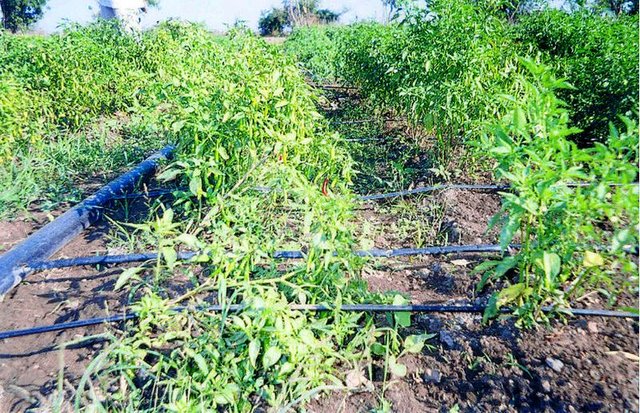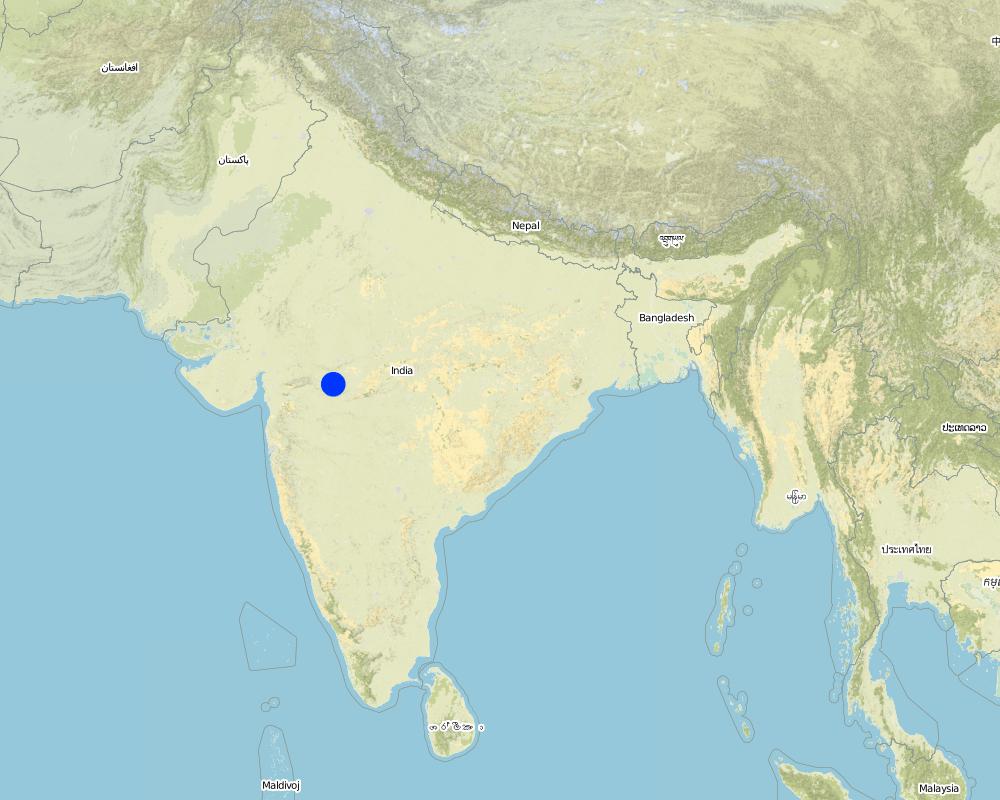Market support and branding for input quality (Krishak Bandhu) [印度]
- 创建:
- 更新:
- 编制者: Shilp Verma
- 编辑者: –
- 审查者: Fabian Ottiger, Deborah Niggli
approaches_2369 - 印度
查看章节
全部展开 全部收起1. 一般信息
1.2 参与方法评估和文件编制的资源人员和机构的联系方式
SLM专业人员:
Sadangi Amitabha
amitabha@ide-india.org
International Development Enterprises - India
C 5/43, Safdurjang Development Area (1st & 2nd Floor), New Delhi 110016
英属印度洋领地
有助于对方法进行记录/评估的项目名称(如相关)
Book project: where the land is greener - Case Studies and Analysis of Soil and Water Conservation Initiatives Worldwide (where the land is greener)有助于对方法进行记录/评估的机构名称(如相关)
International Development Enterprises - India (iDE-India) - 美国有助于对方法进行记录/评估的机构名称(如相关)
International Water Management Institute (International Water Management Institute) - 印度1.3 关于使用通过WOCAT记录的数据的条件
编制者和关键资源人员接受有关使用通过WOCAT记录数据的条件。:
是
1.4 SLM技术问卷的参考

Pepsee micro-irrigation system [印度]
A grassroots innovation that offers most of the advantages of conventional micro-irrigation at a much lower establishment cost.
- 编制者: Shilp Verma
2. SLM方法的描述
2.1 该方法的简要说明
Market development and support through use of a brand name - Krishak Bandhu ('the farmer's friend') - to help ensure quality amongst manufacturers and suppliers of drip irrigation equipment.
2.2 该方法的详细说明
该方法的详细说明:
Aims / objectives: Poor smallholder farmers are generally slow in adopting new technologies, especially when such decisions require relatively large initial investments which only yield returns over a long period of time. Even when subsidies are made available, the high transaction costs act as a hindrance. After more than three decades of promotion by government, and despite subsidies as high as 90%, conventional drip irrigation technology remains exclusively popular amongst 'gentlemen' (better-off) farmers in India. Since it was first introduced in the 1970s, the total area under drip irrigation expanded sluggishly from 1,500 ha in 1985 to 225,000 ha in 1998, which is tiny compared to an estimated national potential of 10.5 million hectares.
Methods: IDE, India (IDEI) is an NGO dedicated to troubleshooting such problems through a unique market development approach. IDEI promotes simple, affordable, appropriate and environmentally sound technologies for poor smallholder farmers through private marketing channels, under the brand name Krishak Bandhu. Donor resources are accessed by IDEI to stimulate markets by creating demand for such technologies and by ensuring an efficient supply chain for the equipment. The key to the IDEI approach lies in its adoption and application of commercial business principles as well as in its path of socio-economic development as a tool to sustainability of programmes. IDEI seeks to create a strong and continuing demand by motivating and nurturing an effective supply chain (including manufacturers, dealers and assemblers of micro irrigation equipment). In West Nimar, Madhya Pradesh (as in the whole of India) IDEI supports the marketing of cheap, good quality equipment for so-called 'Affordable Micro-Irrigation Technologies' (AMIT) such as pepsee (see associated technology). The promoted technology in this case is based on a farmer's innovation, which then was promoted and spread by IDEI.
Stages of implementation: IDEI has intervened in four major ways: (1) technically it has further developed the local innovation, pepsee, and come up with an improvement, aptly named 'Easy Drip'; (2) it has promoted small manufacturers of drip irrigation equipment and associated them with a brand name; (3) it has trained and supported private sector 'service providers' to assist farmers to install and adopt the systems; (4) on an ad hoc basis, IDEI commissions and supports studies on uptake and impact. Technologies promoted by IDEI provide returns on investment of at least 100% in one year which is crucial in explaining the success of pepsee. Within five years the projects supported by IDEI should become self-sustaining.
2.5 采用该方法的国家/地区/地点
国家:
印度
区域/州/省:
Madhya Pradesh
有关地点的进一步说明:
West Nimar
Map
×2.7 方法的类型
- 基于项目/方案
2.8 该方法的主要目的/目标
To bring affordable and appropriate water saving technologies to the rural poor through creating effective supply chains and developing markets, under a brand name associated with reliability.
The SLM Approach addressed the following problems: An underlying problem of increasing growing groundwater scarcity combined with the high investment costs of conventional drip irrigation equipment. On top of this is the reluctance of smallholder farmers to take government subsidies because of the high transaction costs (not easy to access; long delays and the reluctance to adopt new technologies). Local and cheap technological options are available, but quality and marketing channels are not assured.
2.9 推动或妨碍实施本办法所适用的技术的条件
社会/文化/宗教规范和价值观
- 阻碍
Poor consumers are averse to risk and prefer to emulate the success of early-adopters. Hence, there's often a lag period between the introduction of the technology and its poverty impact.
Treatment through the SLM Approach: Every project should become self-sustaining within five years. IDEI therefore establishes the supply chain for manufacturing,IDEI therefore establishes the supply chain for manufacturing,IDEI therefore establishes the supply chain for manufacturing,distri
财务资源和服务的可用性/可得性
- 阻碍
Private business decisions are based on profit margins and volumes and the often fragmented and cash-starved customers do not constitute an attractive market on their own.
Treatment through the SLM Approach: IDEI develops and nurtures the market for low-cost smallholder friendly technologies; thereby providing incentives to private businesses by encouraging growth in the size of the market.
其他
- 阻碍
economic: Poor consumers cannot make large investments and may even be willing to pay a higher per unit price as long as the one-time investment is lowered.
Treatment through the SLM Approach: IDEI identifies and develops appropriate technologies that have high poverty-alleviation potential, are produced locally; are environment friendly; and provide return on investment of at least 100% in one year.
3. 相关利益相关者的参与和角色
3.1 该方法涉及的利益相关者及其职责
- 当地土地使用者/当地社区
Smallholder farmers
Traditionally, irrigation investments in particular, and farming in general, has been male-dominated. However, recent studies indicate that women play a critical role in the decision-making process, as these investments often compete with other household requirements.
- SLM专家/农业顾问
- 国家政府(规划者、决策者)
- 国际组织
3.2 当地土地使用者/当地社区参与该方法的不同阶段
| 当地土地使用者/当地社区的参与 | 指定参与人员并描述活动 | |
|---|---|---|
| 启动/动机 | 互动 | |
| 计划 | 被动 | IDEI carrying out awareness creation etc |
| 实施 | 被动 | |
| 监测/评估 | 被动 | market surveys, studies, assessments initiated and carried out by IDEI |
| Research | 被动 | planned and carried out by IDEI |
3.3 流程图(如可用)
具体说明:
left: Supply channels of AMIT (Affordable Micro-Irrigation Technologies) systems and the role of IDEI right: Key elements of the AMIT marketing strategy
3.4 有关SLM技术选择的决策
具体说明谁有权决定选择要实施的技术:
- 仅限土地使用者(自主)
解释:
on the basis of their specific requirements.
Decisions on the method of implementing the SLM Technology were made by mainly by land users supported by SLM specialists. Mainly by land users supported by specialists/'service providers' (IDEI, the supporting NGO)
4. 技术支持、能力建设和知识管理
4.1 能力建设/培训
是否为土地使用者/其他利益相关者提供培训?:
是
涵盖的主题:
Training and extension are combined: while there are no dedicated training courses, through the network of service providers (who have been trained by IDEI), know-how on drip irrigation is spread among adopter and potential adopter farmers. Brochures and pamphlets (several in the local language) are circulated and there is an informative website.
4.3 机构强化(组织发展)
是否通过这种方法建立或加强了机构?:
- 是,非常
具体说明机构的强化或建立程度:
- 本地
- see Annex A3
4.4 监测和评估
监测和评估是该方法的一部分吗?:
是
注释:
bio-physical aspects were regular monitored through measurements; indicators: improvement in water-use efficiency
technical aspects were regular monitored through measurements; indicators: appropriateness of the technology to different crops and locations; also trying out technologies with new crops
socio-cultural aspects were regular monitored through observations; indicators: impact on women and on the poor
economic / production aspects were regular monitored through measurements; indicators: returns vis-à-vis investments
area treated aspects were regular monitored through measurements; indicators: total scale of adoption; IDEI's estimates suggest that their technologies have so far reached 30'000 families
There were None changes in the Approach as a result of monitoring and evaluation: IDEI carries out a number of studies to investigate the impact of their technologies and the scale and dynamics of adoption. The results of these studies feed into their strategic and operational plans. For example, IDEI was the first to introduce drips in mulberry cultivation in Kolar. That became a huge success story.
4.5 研究
研究是该方法的一部分吗?
是
提供进一步的细节,并指出是谁做的研究:
Apart from research carried out by scientists (published in journals etc) IDEI has its own series of research reports which present the results of various studies on promotion and impact of low cost water saving technologies conducted (see references).
5. 融资和外部物质支持
5.1 该方法中SLM组成部分的年度预算
注释(例如主要的资助来源/主要捐助者):
Approach costs were met by the following donors: international non-government (Donor agencies): 100.0%
5.2 为土地使用者提供财政/物质支援
土地使用者是否获得实施该技术的财政/物质支持?:
否
5.3 对特定投入的补贴(包括劳动力)
- 无
如果土地使用者的劳动力是一项重要的投入,那么是不是:
- 自愿
注释:
No incentives to support labour are given to land users. IDEI supports the whole chain from manufacturers and dealers to assemblers
5.4 信用
是否根据SLM活动的方法给予信用值?:
否
6. 影响分析和结论性陈述
6.1 方法的影响
该方法是否帮助土地使用者实施和维护SLM技术?:
- 否
- 是,很少
- 是,中等
- 是,支持力度很大
The widespread adoption of the pepsee and Easy Drip irrigation infrastructure has greatly improved water use efficiency
6.3 方法活动的可持续性
土地使用者能否维持通过该方法实施的措施(无外部支持的情况下)?:
- 不确定
若否或不确定,请具体说明并予以注释:
Entire approach relies on creation of markets which are initially promoted and supported by IDEI. Too early to say whether the market would be sustained after IDEI withdraws but because of the fact that pepsee was a grassroots innovation and emerged spontaneously, there is a good chance. IDEI keeps a five year horizon for its intervention, and targets that market becoms self-sustaining afterwards.
6.4 该方法的长处/优点
| 编制者或其他关键资源人员认为的长处/优势/机会 |
|---|
| IDEI believes in the essential dignity of people and their capacity to overcome social and economic pressures, problems and exploitations. It therefore treats poor farmers as customers and not recipients of charity. It applies business models to achieve development by tapping and developing small enterprises in the rural economy and creating markets. |
| It applies business models to achieve development by tapping and developing small enterprises in the rural economy and creating markets (How to sustain/ enhance this strength: Further promote market creation and then let the market forces take off on their own.) |
| The IDEI market creation approach to development ensures that there is awareness and availability of low-cost products that will have a high poverty alleviation impact (How to sustain/ enhance this strength: Ditto) |
| Growth in this approach will take place if the supply chain is performing and profitable. The early adopters may not be the poorest but if the product meets the needs of the farmers, the rural poor will follow suit and considerable market growth could result, creating a sustainable supply channel (How to sustain/ enhance this strength: Ditto) |
6.5 该方法的弱点/缺点以及克服它们的方法
| 土地使用者认为的弱点/缺点/风险 | 如何克服它们? |
|---|---|
| IDEI needs to work more closely with the government agencies. While market creation seems to be a very useful model, it needs to tap the government resources which are pumped every year in the business of promotion of drip irrigation. |
| 编制者或其他关键资源人员认为的弱点/缺点/风险 | 如何克服它们? |
|---|---|
| IDEI's reach is dependent on its ability to access donor funds. This might become a limitation at some stage. |
7. 参考和链接
7.1 方法/信息来源
- 实地考察、实地调查
- 与土地使用者的访谈
7.2 参考可用出版物
标题、作者、年份、ISBN:
IDEI Affordable Micro Irrigation Technologies: Marketing Manual. International Development Enterprises, USA.Phansalkar, S.J. (2003). Appropriate Drip Irrigation Technologies Promoted by IDEI: A Socio-Economic Assessment. International Development Enterprises, India (IDEI),Verma, S., Tsephal, S. and Jose, T. (2004). Pepsee Systems: Grassroots Innovation under Groundwater Stress. Water Policy,
标题、作者、年份、ISBN:
Phansalkar, S.J. (2003). Appropriate Drip Irrigation Technologies Promoted by IDEI: A Socio-Economic Assessment. International Development Enterprises, India (IDEI),
标题、作者、年份、ISBN:
Verma, S., Tsephal, S. and Jose, T. (2004). Pepsee Systems: Grassroots Innovation under Groundwater Stress. Water Policy,
链接和模块
全部展开 全部收起链接

Pepsee micro-irrigation system [印度]
A grassroots innovation that offers most of the advantages of conventional micro-irrigation at a much lower establishment cost.
- 编制者: Shilp Verma
模块
无模块



